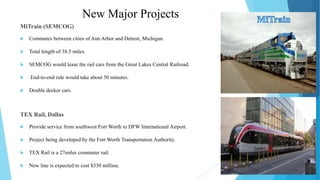Presentation1
- 1. Taking America to Work Presentation By : Suraj Prasanna Kumar
- 2. Introduction to Commuter Rail ïĩ Connects downtown central business district with surrounding suburban. ïĩ Oldest of all railway passenger systems. ïĩ 28 commuter rail system-over 6,600 commuter rail vehicles. ïĩ Long distance trips with fewer station stops and economical fare. ïĩ Found only in large metropolitan areas. A-Train, Denton Tri-Rail, Miami
- 3. History ïĩ U.S. railroad companies imported technology from Britain in the 1830s. The B&O established its Rail manufacturing unit in Baltimore in 1829 , which was the first railroad manufacturing facility in the U.S ïĩ Commuter rails were owned and operated by private railroad companies. ïĩ 1920âs â the golden age of rail. ïĩ Private companies began to discontinue rail service. ïĩ Public authorities were created. ïĩ Quasi-Public transit operations started everywhere by 1970âs.
- 4. Characteristics of Commuter Rail ïĩ Typical Design: âĒ Diesel or Diesel-electric powered. âĒ Length: 20 to 50 miles. âĒ Station spacing: 3 to 4 miles. ïĩ Typical operations: âĒ Average speed: 30 to 50 mph with stops. âĒ Max speed: up to 79 mph. âĒ Frequency: every 30 mins in peak periods. ïĩ Land development: âĒ Effective for lower-density suburban areas. âĒ Depends on park and ride lot facilities. âĒ Moderate economical development potential. Rail Runner Express, New Mexico Capital MetroRail, Austin
- 5. Advantages of Commuter Rail ïĩ Right of way and infrastructure are already in place. ïĩ Efficient way to transport large volume of people. ïĩ Deals with traffic congestion. ïĩ Increase in the land values. ïĩ Long distance travel with fewer stops. ïĩ Faster trips than other transit modes. ïĩ Capital cost can be modest compared to other rail modes. ïĩ Average cost of vehicle operation per passenger mile for commuter rail is less than light rail (APTA 2002). Source: Litman 2010
- 6. Transit Ridership 2015 Ridership 1st Quarter 2nd Quarter % Change 115,511,000 124,344,000 7.65 2014 Ridership 1st Quarter 2nd Quarter 3rd Quarter 4th Quarter % Change 114,764,000 124,324,000 125,851,000 124,507,000 8.5 SOURCE: http://www.apta.com/resources/statistics/Pages/RidershipArchives.aspx Unlinked Passenger Trips: The number of passengers who board public transportation vehicles
- 7. Major Commuter Rail Systems Transit agency MTA Long Island Railroad Metro North commuter Railroad FTA Number 2100 2078 System Operator MTA MTA Friegth Operator New York Railway Canadian Pacific&Norfolk Southern Established 1966 1983 Classification Legacy Legacy Route Miles 321 385 Stations 124 122 Daily Ridership 0.3 Million 0.29 Million 2014 Ridership 98 Million 84 Million 2012 Fare Rates $3- $25.00 $2.25-$22.00 2009 Total Expenditures 1104 Million 858Million Per passanger Mile $0.57 $0.39 Per passanger Trip $11.35 $10.80 Long Island Railroad, NY Metro-North Railroad, NYSource: National University Rail Center
- 8. Major Commuter Rail Systems Transit agency New Jersey Transit Corporation NIRCRC FTA Number 2080 5118 System Operator Herzog Transit Services NIRCRC & PSA operations Friegth Operator Conrail & Norfolk Southern BNSF & Union Pacific Established 1983 1984 Classification Legacy Legacy Route Miles 398 488 Stations 164 241 Daily Ridership 0.24 Miliion 0.3 Million 2014 Ridership 87 Million 75 Million 2012 Fare Rates $2-$16.0 $2.75 - $9.25 2009 Total Expenditures 842 Million 550 Million Per passanger Mile $0.36 $0.33 Per passanger Trip $10.07 $7.84 New Jersey Transit, NJ Metra, Chicago
- 9. New Major Projects MiTrain (SEMCOG) ïĩ Commutes between cities of Ann Arbor and Detroit, Michigan. ïĩ Total length of 38.5 miles. ïĩ SEMCOG would lease the rail cars from the Great Lakes Central Railroad. ïĩ End-to-end ride would take about 50 minutes. ïĩ Double decker cars. TEX Rail, Dallas ïĩ Provide service from southwest Fort Worth to DFW International Airport. ïĩ Project being developed by the Fort Worth Transportation Authority. ïĩ TEX Rail is a 27miles commuter rail. ïĩ New line is expected to cost $330 million.
- 10. New Trends MBTA- Massachusetts Bay Transportation Authority
- 11. Issues with Commuter Rail ïĩ An accident occurs, on average, once every two days on the passenger and commuter trains, according to a USA TODAY analysis of federal rail data. ïĩ Safety issue: Federal Railroad Administration (FRA) data reveal that 27 railroads reported 2,259 accidents, including 779 derailments and 101 collisions, during the past 11 years, according to the analysis. ïĩ Delays due to weather conditions. ïĩ Suicides are increasing over years: Actions are needed to prevent suicide on commuter rails.
- 12. THANK YOU











